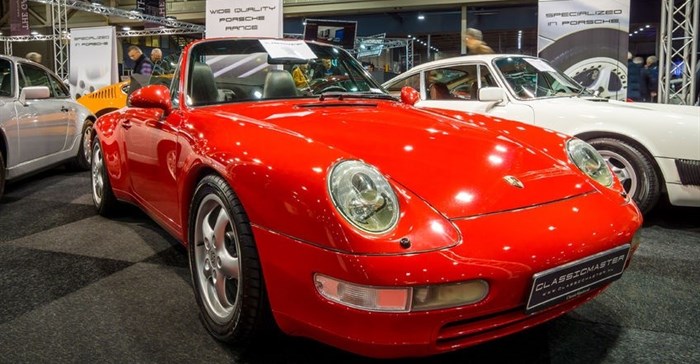






Comparing other asset classes, the KFLII shows that in second place was fine wine with growth up 9%, followed by rare coins in third position, up 6%. Art and furniture were the biggest losers, dropping by 5% and 6%, respectively, it says.
“Ferraris and Porsches have comfortably outperformed many leading global hedge fund managers over the past decade, with returns from the world’s top marques driving classic cars to triple-digit returns,” the report says. Models from the ‘80s and even newer are seeing the fastest growth. This is not surprising considering that guys who are now in their 40s are feeling nostalgic for the dream cars they had Prestiked to their bedroom walls when they were 10 years old.
Brian Webb of Crossley & Webb in Cape Town concurs: “Over the last two years I’ve seen dramatic increases in prices locally particularly with Ferrari — Testarossa and 308s are very strong and have literally doubled in price. We’ve just sold a 1973 Porsche RS for R10m and a 964 3.6 Turbo for R2,5m. The 964 is the Holy Grail. Targas are also increasing in value and I’m even seeing a resurgence of the 993 and 996 models.”
The Historic Automobile Group International (HAGI), an independent investment research company and think tank with specialised expertise in the rare classic car sector, publishes annual indices that are among the most respected tools to monitor the price development for any vehicle. Their latest index shows annual price change (June 2015 to May 2016) for Porsche of 16%, Ferrari 11%, and Mercedes-Benz 3%.
HAGI may be one of the go-to guides, but human behaviour can be a little unpredictable. Invite a few men to an auction and not even the auctioneers can predict the outcome. As Webb reminds me: “UK Radio 2 DJ Chris Evans famously paid £12m for a 1963 Ferrari 250 GTO in 2010 and everyone thought he was insane.” Clearly he was onto something though as two years later Sir Stirling Moss’s apple-green 1962 Ferrari 250 GTO sold for more than twice that amount.
Added to this is the uncertain market behaviour post the recent Brexit vote. Rob Sass, publisher of Hagerty Classic Cars magazine says: “We’re in for a bumpy ride”. Hagerty is the leading global insurance agency for collectable cars. They also track and report on trends and publish lists of cars they believe will be collectible in the future. Sass reports on their website that the very top of the market has been quiet of late. “The Hagerty Blue Chip Index has levelled off after years of torrid growth. Some attributed it to demand at the top meeting current supply. Others sensed an attitude of extreme caution.”
However, he advises “ordinary collector” not to panic. “If you own one or two cars, which you purchased for fun, any market correction should be irrelevant to you. And if the collector car market does deflate for a time, then treat this as a buying opportunity,” he says.
Apart from highly collectable top marques that have been fetching off-the-charts prices, for newcomers the market is quite accommodating and there is something to suit everyone’s pocket. As long as you spend in your price bracket but aim for the best possible quality. Like any investment, if you are going to drop the cash, you need to consult the experts and do your homework to avoid any nasty surprises.
Long-term, the drivers of growth in the segment are sustained by an increase in HNWI numbers and younger buyers who also continue to enter the market. So as Generation-X drives the new wave of buying and nostalgically eye “classics” from the ‘80s and ‘90s, maybe the larger production numbers don’t matter as much? Who knows, with some even younger buyers looking to stand out from the crowd but still wanting reliability, we are bound to see growing interest in early performance model sedans like the BMW M3 (E36) and “hot hatches” like the Ford Focus RS or ST, first generation VW Golf GTi or CTi, and Japanese coupes.
“There are three kinds of buyers: collectors, who have plenty of money and space to store their collections, and who look for rare cars; first-time buyers looking for something different but practical; and repeat buyers. If you only have space for one car then a 911 or Merc R107 makes sense as they have all the mod-cons like a/c and power steering and can be enjoyed as a daily drive. Demand for cars also depends on age. Ten years ago it was the muscle cars of ‘30s and ‘40s and now it is 911s and the Magnum PI Ferrari 308,” he says.
At the top of the pyramid there is plenty of disposable wealth but how are most buyers funding their habits? Banks haven’t woken up yet and are still happier to finance a depreciating “asset” rather than cars, which at the very least, hold their value over time. Buyers in their 40s and early 50s are taking a serious look at their financial portfolios, their RAs, and the long-term view is generally that they are better off making a withdrawal and investing in classic cars.
Spikes in property values over the last few years also means that many buyers are able to tap into their access bonds for cash at lower lending rates.
The great benefit of investing in the right classic is not only its potential hedge value but it is a tangible asset that will bring you tons of joy, which the stock market seldom offers.
“Restoration projects are popular, but owning a classic is now also about making a fashion statement and Porsche is very popular for this,” says Webb. “They are affordable and keep pace with inflation. Parts and servicing are available and of course it’s a recognisable status symbol.”
Webb predicts that cars like the MGB GT are on the up and has seen an increase in value in the UK from £5,000 to £10,000 in the last two years. “This is still affordable but an indication of where things are going. We sold a 1962 MINI Cooper for R200000. It wasn’t even a Cooper S.”
Our modern world makes little sense anymore but as things become more hi-tech and societies to a large extent become more homogenised, a recurring theme every generation is individuals reacting by seeking out the old, the unusual. Whether it’s driven by 40- or 50-somethings experiencing a mid-life crisis or planning better for their futures, or a hipster looking for more than a beard and a “fixie’, or whether it’s just pure nostalgia, the writing is on the wall. An investment in a classic is an investment with many rewards.